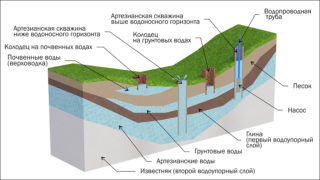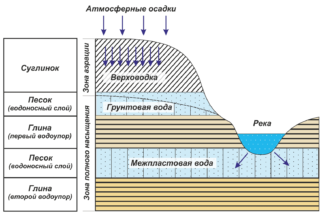To create an autonomous water supply system on the site, you initially need to make your own source. For this, it is important to find out at what depth the water for the well is. This will greatly facilitate the task, help calculate your strength, select the necessary equipment for drilling.
General information about aquifers

In order not to run into an aquifer of poor quality, it is important to know about the characteristics of a particular horizon, since not all of them are suitable for domestic use, especially for drinking, cooking.
All aquifers are strata underground with a ceiling (top) and a bottom (bottom). As a rule, these are layers consisting of clay, stone or limestone. They contain water either under pressure or without it. In the first case, the reservoir is called pressure head, in the second - free flow.
All aquifers are not flat. They tend to bend, form turns, height differences. Therefore, wells of different depths can be located on the same horizon.
To find a resource underground, it is advisable to use hydrogeological maps of the area. They are usually found in the archives of a particular locality.
According to the depth of occurrence, all aquifers are divided into types:
- Verkhovodka. These are the first 2.5-5 meters from ground level. Such layers contain all the water that has been absorbed from the soil during the rains, has gone into the ground from drain pits, and has seeped from industrial enterprises. Such a resource is unsuitable for drinking, as it often has a strong level of contamination with toxic poisons, pesticides, nitrates, acids, etc.
- Sand layers. They are located at the level of 8-12 meters and more. It is believed that the water here is purified as much as possible, since it went through many levels of filtration until it got from the surface to this horizon. It is to this depth that wells are often dug or wells are drilled on the sand.
- Artesian deposits. They go 50-200 meters deep. Such water is already considered to be mineral. A license is required for an artesian well, since the water resources here are under state protection. It is unrealistic to search for an artesian source using folk methods.
It is better to drill artesian wells for several houses at once, since they have a very high flow rate. For one family, this water will be in abundance.
Preliminary exploration of the deposit

In order to search for water in the area for the well as accurate as possible, it is advisable to conduct a hydrogeological and geophysical survey, exploratory drilling. When performing such work, the master not only determines the depth of the underground source, but also reveals:
- the level of soil subsidence;
- categories and complexity of their penetration;
- the nature of the stability of each soil layer during drilling.
Exploration can be done in several ways:
- Rotary. This implies the rotation of the drill with flushing the source column.
- Columnar. It is used for great depths, since the drilling equipment is capable of cutting rocks.
- Shock rope. Here, an exploration well is drilled under the influence of the weight of the projectile, lowered from a height.
It is better to invite specialists to carry out exploratory drilling.
Methods for finding groundwater at the site
It is quite possible to find a place for a well on the site yourself if you apply special techniques. One of them is considered to be electrical sounding.For this, devices are used - current recorders.
In vertical electrical probing, different soil layers (underground rocks and aquifers) produce different electrical resistivity. Water deposits have lower rates than mineral skeletons.
The disadvantage of this method is as follows - an error in determining the depth of the aquifer is possible if there are deposits of iron ore in the earth. They distort the readings of the recorder. The same thing happens when you are close to the study site of iron fences, a railway track.
How to find water on your own

To determine where to drill a well under water, the following methods are considered the most common:
- Operation of a clay pot. It must be positioned upside down at the proposed drilling location. If there is an aquifer, the clay will pick up moisture overnight.
- The use of glassware. You can use regular 0.5 liter cans. Several such vessels are placed around the site in the evening, neck down. The one that will contain more condensation in the morning indicates the presence of water underground.
- Using silica gel. It must be wrapped in a dry piece of cloth, placed in a clay container and buried in the proposed drilling location. The silicate balls must be weighed beforehand. After a night in the ground, the container is dug out and the mass of the gel is measured. Thus, the level of its moisture saturation is determined.
- Aluminum frames. An old method that our grandfathers used to choose a place for a well. To conduct the study, you need to take two pieces of aluminum wire, 40-50 cm each. One end of each of them must be bent at a right angle by about 10 cm. Then the wires are inserted into special hollow tubes without a core (preferably from elderberry). Holding such a framework in their hands, they walk around the site. It is important to press your elbows to the sides. If the craftsman passes over an aquifer, the aluminum frames are crossed. This place must be marked and walk along it again, but perpendicular to the original direction. Where both lines converge and it is worth drilling.
Instead of aluminum wire, you can also use cuts of grape, willow vines. They must be dried well beforehand.
Folk omens
You can find the presence of an aquifer in a site using the observation method. There are a number of sure signs of groundwater location:
- Morning fog. As a rule, in places with the maximum availability of water underground, it spreads thickly, swirls and does not come off for a long time. The more fog, the closer the desired layer is to the surface of the earth.
- The presence of different plants. If their root system in the proposed drilling site is too weak, then the groundwater is close to the surface. If the roots grow deeper, they have a powerful appearance, the water here is at a level of several tens of meters. In turn, certain groups of plants can be found and tracked, which are indicators of the presence of water underground. These are nettle, sorrel, coltsfoot, alder, willow.
- The maturity level of fruit crops. It is believed that if cherries, sweet cherries and pears are constantly rotting, the desired horizon passes close to the surface of the earth.
- The behavior of animals in hot weather can also influence the choice of drilling site. Dogs and horses are indicator specimens. The first ones always dig a hole in places of high humidity and fit into it. Horses in this place zealously beat their hoof. They strive for moist soil and geese, released for a walk in the heat.
- Moshkara also helps to find out about the presence of the desired resource underground. It swarms in the evening where there is definitely a hidden source.
It doesn't hurt to walk around the neighbors and find out from them at what level their wells and wells operate. What earlier results of deepening with a drill did they get, and at what level it is impossible to drill, so as not to exhaust the flow rate of one layer, if several wells are fed from it.








